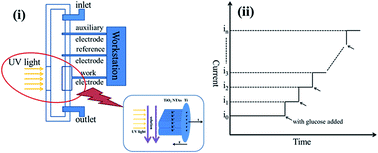Photoelectrochemical detection performance and mechanism discussion of Bi2O3 modified TiO2 nanotube arrays
Abstract
Bi2O3 were deposited on anodized TiO2 nanotube arrays by chemical bath deposition combined with calcination. The structures, elemental compositions and morphologies of the products were investigated by X-ray diffraction, X-ray photoelectron spectroscopy, field-emission scanning electron microscopy and high resolution transmission electron microscopy respectively. The photoelectrochemical behaviors of TiO2 and Bi2O3/TiO2 NTAs were measured by cyclic votammetry and amperometry combined with a UV LED source. Modification of Bi2O3 on TiO2 nanotube arrays was found to decrease the photocurrent in buffer solution and increase the current response to organics addition at the same time, both of which are benefit for photoelectrochemical detection of organic compounds with high sensitivities. The mechanisms of Bi2O3 modification were further studied by analyzing the whole photoelectrochemical processes, including the optical absorption, charges transfer and surface electrochemical reactions. The photoelectrochemical COD sensor based on the optimized Bi2O3/TiO2 NTAs can achieve the detection performances with sensitivity of 1.8033 μA (mg L−1)−1 and COD range of 0–288 mg L−1.

- This article is part of the themed collection: Nanoscience and nanotechnology in electrochemistry

 Please wait while we load your content...
Please wait while we load your content...